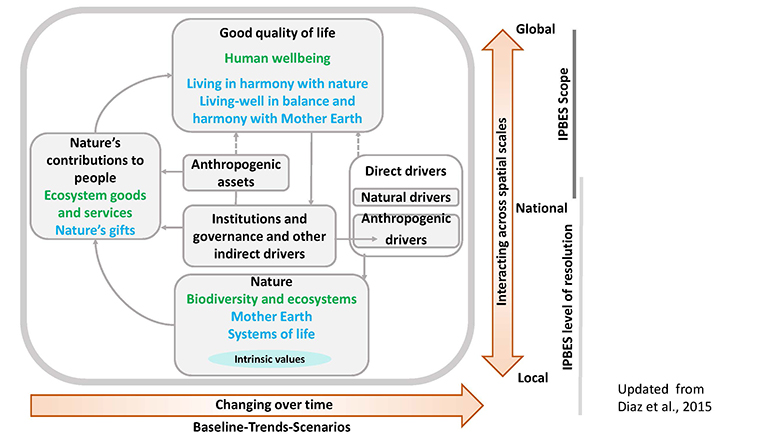Conceptual Framework
Rationale for a conceptual framework for the Platform
The Plenary requested the development of a conceptual framework to give cohesion to the objective, functions and relevant operating principles of the Platform and the relationship among them. Such conceptual framework needed to provide an integrated view of the biodiversity knowledge–policy interface, stimulate new thinking, accommodate diverse human attitudes to biodiversity, and at the same time be as simple as possible to be effective and useful for the diverse array of stakeholders. The conceptual framework adopted by IPBES rises to this challenge.
The Plenary adopted the IPBES conceptual framework in its decision IPBES-2/4. In decision IPBES-5/1, the Plenary noted that the concept of nature’s contributions to people would be used in current and future IPBES assessments. The concept of “nature’s contributions to people” has since replaced the use of the phrase “nature’s benefits to people” that had been used in the conceptual framework as initially adopted.
The conceptual framework for biodiversity and ecosystems services is to support the analytical work of the Platform, to guide the development, implementation and evolution of its work programme, and to catalyse a positive transformation in the elements and interlinkages that are the causes of detrimental changes in biodiversity and ecosystems and subsequent loss of their benefits to present and future generations. This conceptual and analytical tool is to underpin all IPBES functions and provide structure and comparability to the syntheses that IPBES will produce at different spatial scales, on different themes, and in different regions.
Salient innovative aspects of the conceptual framework are its transparent and participatory construction process and its explicit consideration of diverse scientific disciplines, stakeholders, and knowledge systems, including indigenous and local knowledge. In this sense, the conceptual framework is a tool for the achievement of a shared working understanding across different disciplines, knowledge systems and stakeholders that are expected to be active participants in the Platform, and is intended to be a basic common ground, general and inclusive, for coordinated action towards the achievement of the ultimate goal of the Platform.
Structure and elements of the conceptual framework
The conceptual framework set out below is a highly simplified model of the complex interactions between the natural world and human societies. The model identifies the main elements, together with their interactions, that are most relevant to the Platform’s goal and should therefore be the focus for assessments and knowledge generation to inform policy and the required capacity-building.
The Platform’s conceptual framework includes six interlinked elements constituting a social-ecological system that operates at various scales in time and space:
- nature;
- nature’s contributions to people;
- anthropogenic assets;
- institutions and governance systems and other indirect drivers of change;
- direct drivers of change; and
- good quality of life.
These elements and their interrelations are further explained in the conceptual framework adopted by IPBES and in two scientific publications building on that decision. Further, a set of e-learning modules explaining the conceptual framework has been developed Sub-Global Assessment Network (SGAN), a collaborative supporter of IPBES.
An Information note on applying the concept of “nature’s contributions to people” developed by the Multidisciplinary Expert Panel is available here.

An Information note on applying the concept of “nature’s contributions to people” developed by the Multidisciplinary Expert Panel is available here